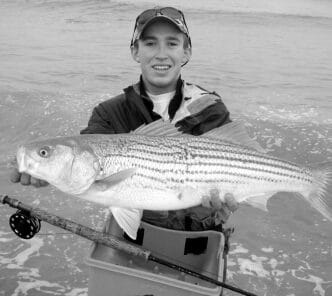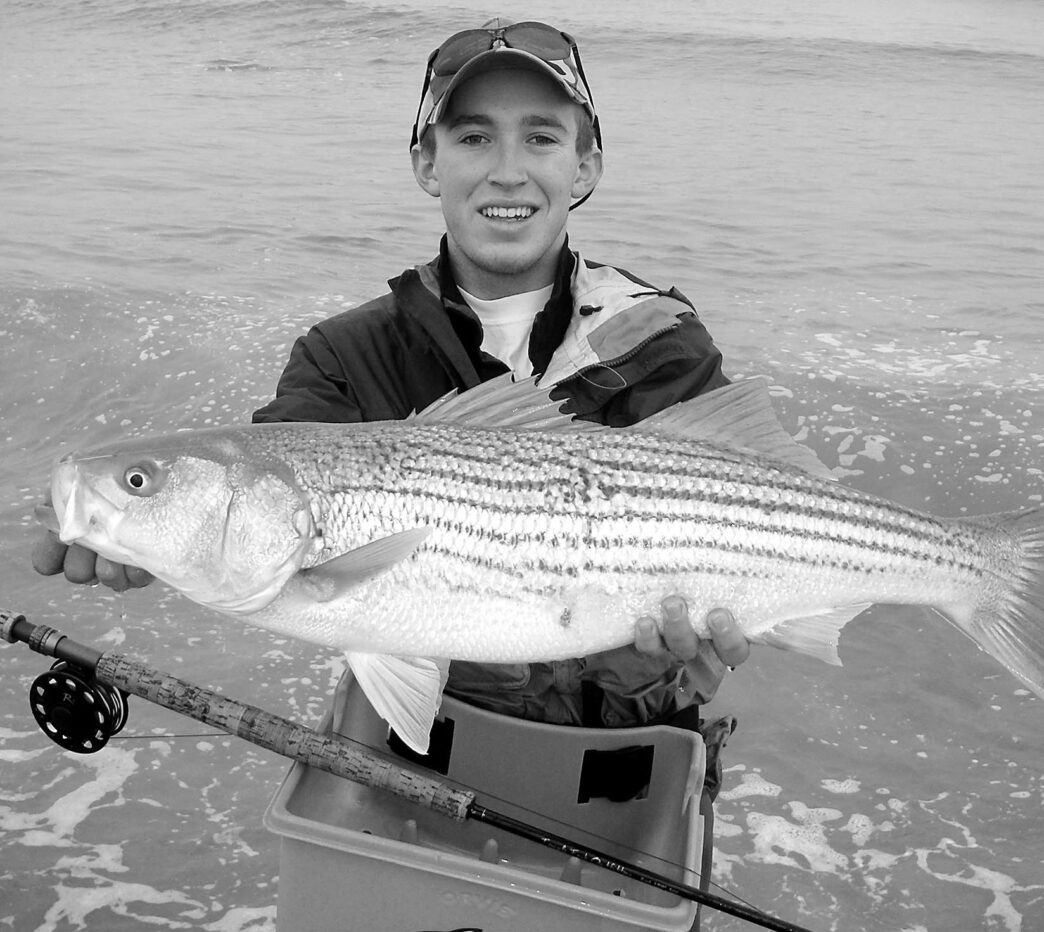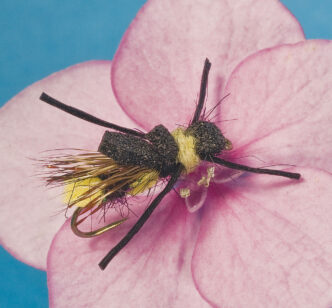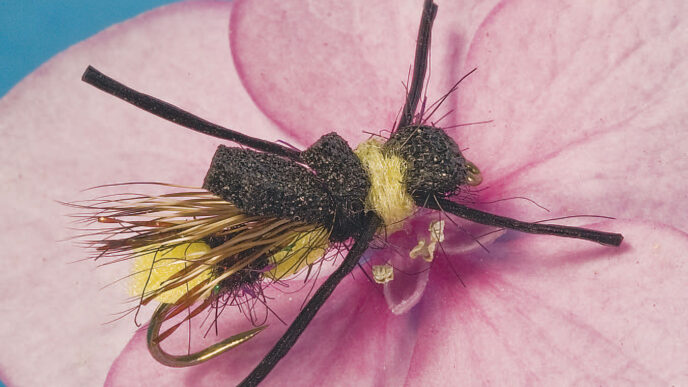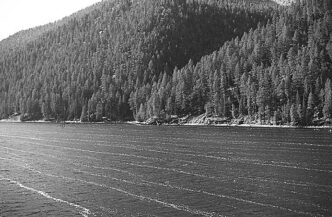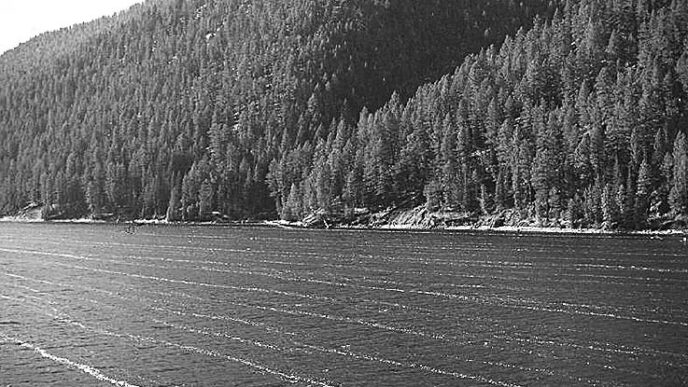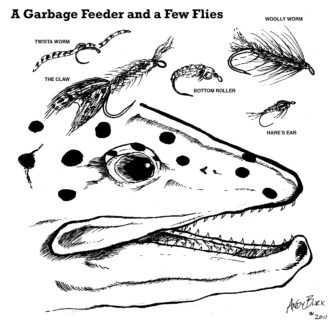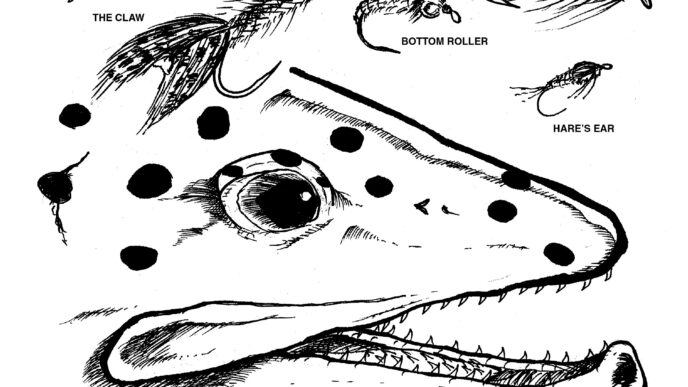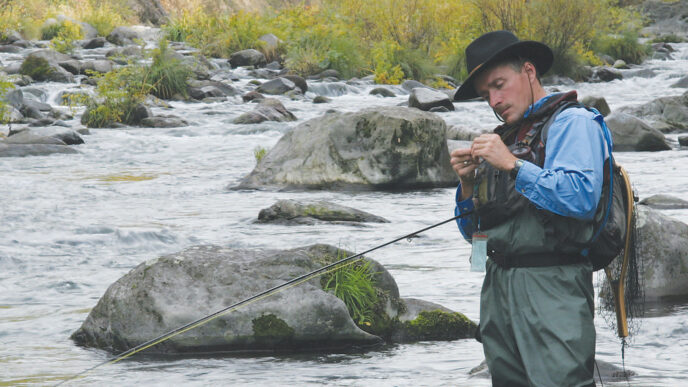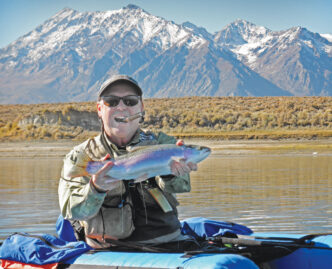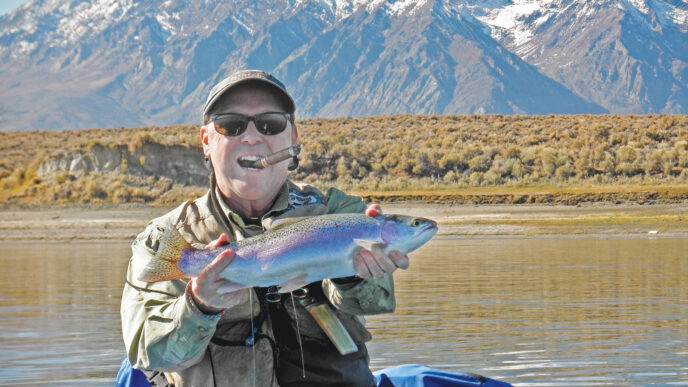Trophy hunting for big striped bass in the surf on the California coast is a low-percentage game. Steelhead are said to be the fish of a thousand casts, but in the surf environment, so are stripers. Though big stripers were once abundant, the numbers of double-digitweight bass along California’s beaches have hugely declined, due to a number of man-made problems. Stories from older anglers older about Montauk-like blitzes in the 1960s and 1970s are a bittersweet hint of what I never experienced.
However, in this challenge lies reward. Unlike the Delta or San Francisco Bay, where stripers often congregate in large numbers and can provide fast action, on the coast, they tend to show up sporadically, here one day and gone the next. With far lower concentrations, it becomes easy to doubt one’s strategy, timing, and location. Catching stripers in the California surf zone comes down to fishing each cast with confidence for that one single strike, knowing full well that the water below the tumbling waves could be devoid of fish.
Not many pursue these poor odds with a fly rod, but for those who do, there is no more thrilling West Coast angling experience than hooking and landing a trophy striped bass in the unforgiving surf. With the right tactics, the chances of doing so can be taken to the next level.
Stripers in the Surf
Stripers in the surf zone are there for one reason: to eat. As a result, they will engulf almost anything resembling prey. If it were comfort they were after, these fish would stay in the Delta, San Francisco Bay, or the depths of the ocean past the breakers. The surf, however, provides a smorgasbord of forage possibilities that includes sand crabs, bloodworms, various shrimp, surfperch, and smelt, among other fare. In this rough-and-tumble environment, these food sources are made especially vulnerable. Crustaceans are kicked up out of the sand by wave action, and baitfish are disoriented and less wary of predators. As a result, striped bass come into the shallows of the surf to munch.
For the same reasons that it is a great zone for these fish to find food, it is also vitally important that they be opportunistic and quick there. With the washingmachine effect of the suds, a bass must commit quickly to sucking down its next meal before the morsel is swept out of sight. As a result, there are no subtle, sponge bites in the surf, as there are in the Delta during the winter. Grabs will almost always be violent as the fish eat and turn away, setting the hook in the process. Because they eat almost anything that looks like food in this environment, when I’m not catching fish, I do not question whether my fly is right, but rather whether my fly is being seen or whether there are bass present at all.
Because of the low probability of hooking a big striper in the surf, it is easy to fall back on hedging your bets and using surfperch tactics in hopes hooking up with whatever might be present. Perch are great fun and a worthy game fish in their own right. And yes, you can catch striped bass with surfperch tactics. A 6-weight rod rigged with a T-11 tungsten shooting head and a mole crab pattern will catch stripers, and potentially big ones. Mark Won, likely the most dedicated surf fly angler in California, can attest to this. While perching, he has caught striped bass in excess of 20 pounds on ultralight fly rods and size 8 flies.
That said, hedging one’s bets to enjoy the fast action of perch fishing with the outside chance of hooking a striper simply does not afford very good chances at doing the latter. With the relatively low numbers of striped bass seasonally present, it is necessary to commit to chasing that one chance at a strike and giving up chances at other catches, such as perch and flatfish.
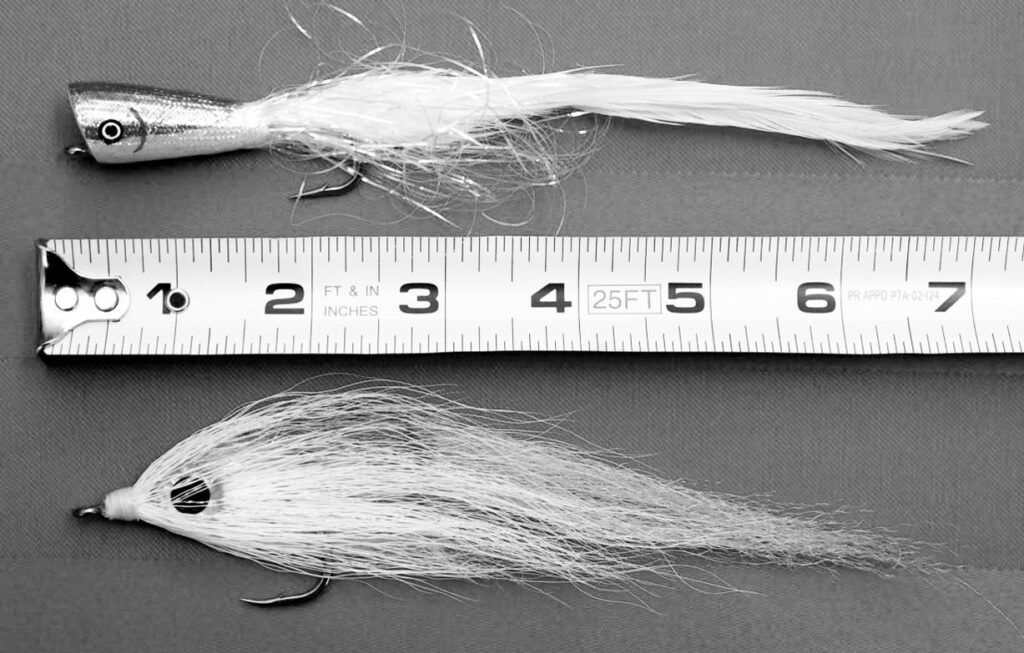
Big Fish, Big Flies, Big Tackle
So what does this need for commitment mean? It means maximizing one’s chances of hooking the fish of a lifetime by using the right equipment and tactics and targeting the types of structure that big bass favor.
The most exciting place to start is with the fly. Dave Sellers and Steve Cali, a couple of very skilled California surf anglers, began experimenting a number of years ago with flies far larger than anything anyone else had been throwing on the West Coast. Between Sellers’s background in trophy striper hunting on San Luis Reservoir, O’Neill Forebay, and the Delta and Cali’s phenomenal fly-tying skills, they pioneered new techniques. Sellers knew that big bass will take big flies, and what better place than from the beach, where foot-long perch, smelt, and even juvenile striped bass are prime targets? Cali could tie an eight-inch fly that that was as easy to cast as a four-incher. These two pushed the envelope and discovered the most effective surf flies for big bass.
The idea was to increase the chance that the fish can feel or see the fly. Their large flies push a lot of water, and the inclusion of lots of flash helps to draw the stripers’ attention. The results have been double-digit stripers caught off the beach in numbers that these anglers hadn’t before experienced. Of course, their perch numbers have dropped to zero, and schoolie stripers have become more infrequent, but the tradeoff has been well worth it.
As I began fishing with Sellers in the surf, I could not believe the size of the flies he would produce from his box and proceed to cast effortlessly. The trick, I later learned, is to use synthetic materials that do not absorb water and to tie the flies in a way that reduces fouling during casting. This maximizes quality presentations with these huge flies, something simply not possible with similar patterns that lack these specific attributes.
The techniques pioneered by Sellers and Cali shaped the way I target striped bass in the surf, and these outside-the-box flies became normal for me after I’d seen enough average bass inhale them like undersized appetizers. These fish would likely eat marlin flies, if you could cast one all morning, with bigger really being better, as long as it can be fished effectively. One simply has to witness a conventional-tackle angler fishing a bowling pin of a plug to see evidence of this.
The fly is only one of a number of im-portant factors in maximizing your chances at a monster striped bass in the surf, however. The type of structure can be a key to success, as well. When perch fishing, covering water is my top priority. I cast, step, cast, working my way down the beach. Of course, certain types of structure are more likely to produce than others, and I spend more time around these areas, but perch can be found in a number of types of water, from shallow to deep and slow to fast. When perching, you move to find concentrations of fish.
My perspective on striper fishing is the opposite. With big bass especially, deep rip currents and holes are far more likely to produce than adjacent shallow flats that could fish very well for perch. With the exception of times of very low light, big bass tend to stick to these deep areas. It is my belief that large bass spend only a very limited amount of time in the surf within range of the shorebound fly caster, and when they do, it is deep structure that provides an easy path for these big fish to move in close to the beach from the outer break.
Because of this, when I find a deep rip current with a fishy-looking foam line, I stay put and fish it with intensity, anticipating a strike on each cast. I continue this until the tide has changed enough to alter the rip or my access to it. I assume that that if a big bass is going to come in close to the sand anywhere along this stretch of beach, the piece of structure I am fishing will be the most likely place for it to happen. As a result, I fish hard and don’t waste prime parts of the tide with my fly out of the water, moving from one spot to another.
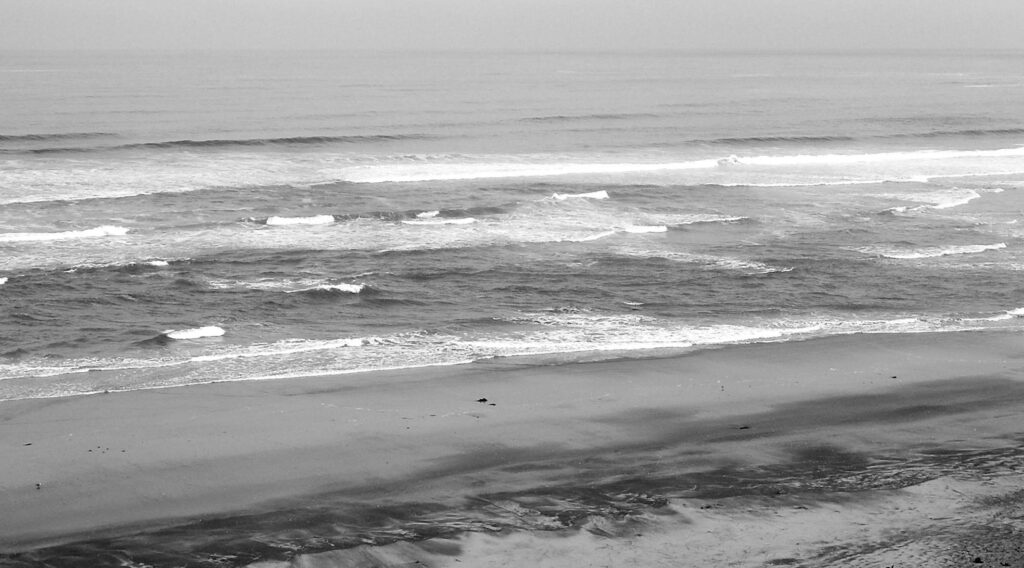
This approach has been rewarded on a number of occasions when, after multiple hours of tedious blind casting, I have caught the fish that made my week, using the same cast I had been making the entire session. It can be a simple matter of waiting the fish out in the right spot, and if I do not hook up, I know it is either because the fish never showed up that day or because my fly went unseen. The second possibility is the one that can be minimized with large-profile, high-contrast flashy flies. Fishing the right structure with the right fly can be taken one step further to maximize you opportunity to catch a big bass in the surf. In deep rips and holes, it is beneficial to fish the opposite part of the water column from where one fishes for perch. Instead of fishing sinking heads with imitations of small crustaceans near the bottom, I follow in the footsteps of Sellers and Cali, fishing intermediate and floating shooting heads, usually with unweighted streamers and, at times, Crease Flies and poppers.
Big streamers and poppers can be difficult to cast in the wind that always seems to be blowing at the beach, but adding small dumbbell eyes to a streamer can help to turn it over at the end of the cast when an unweighted fly won’t. A slightly faster-sinking line, with its narrower diameter, will cut though the wind better, as well.
I usually start the morning with a floating head and popper or intermediate head and unweighted streamer, and once an onshore breeze starts, I switch to a Type III slow-sinking head with a slightly smaller fly with dumbbell eyes. With an intermediate or floating head, it is possible to cast an unweighted fly into a rip and keep it in the zone for a very long time, slowly twitching and swinging it, like making a steelhead presentation in the current, with the fly staying high in the water column. The take of a big linesides right at the surface is thrilling. Seeing the big fish thrash when it comes tight and then takes off for the outer break is an incredible rush, and I don’t think I’ll ever grow accustomed to it.
So think big — literally — and fish big flies on or near the surface for big fish. To do that, the rod must be up to the task. If fishing a single-handed rod, I recommend a 9-weight or 10-weight with 350-to-400-grain shooting heads. Anything lighter can’t consistently cast the fly sizes necessary for trophy bass hunting. A 9weight is my go-to single-hander, because it can handle almost all flies, and a 10weight begins to fatigue me more quickly, though it can cast a 4/0 Crease Fly with a little more ease for a limited time.
The alternative is to fish a doublehanded rod for overhead casting. Beware of most Spey rods, though, because they are not designed for overhead casting and as a result usually do not have a fast enough action for jumbo flies. This means they will buckle when it comes to throwing a megasized fly into an onshore breeze to reach a rip current 80 feet out. These rods shine with smaller flies and calm conditions, but are not ideal for the specific tactics necessary for casting big flies to big stripers in the surf zone. A true beach rod designed for overhead casting, as opposed to Spey casting, will have a much faster action. This translates to quicker recovery in the casting stroke and better results. Extrafast switch rods can also be used effectively for fishing the surf.
Regardless of the rod I am fishing, I always use a monofilament furled leader attached to a short section of stout tippet. This type of leader greatly enhances fly turnover, especially with large, wind-resistant patterns. Stripers in the surf are not leader shy, so there’s no need to get fancy with tippet. I connect 24 inches of 20-pound-test to my fly with a loop knot and call it good. (Editor’s note: A furled leader made of monofilament is also known as a “twisted leader.” You can find them for sale in some fly shops, as well as on the Web by entering “twisted leader” into your search engine. It’s worth noting that Leo Gutterres of Stockton has been instrumental in developing twisted leaders.)
Getting Started
To experience the excitement of a 10-plus-pound striped bass on the fly in the surf, I recommend that you begin by fishing protected waters such as Monterey Bay, Bolinas Bay, and Bodega Bay. The semiprotected nature of these areas will help shorten the learning curve involved in making the jump from flyrodding for surfperch to targeting big striped bass in the surf zone.
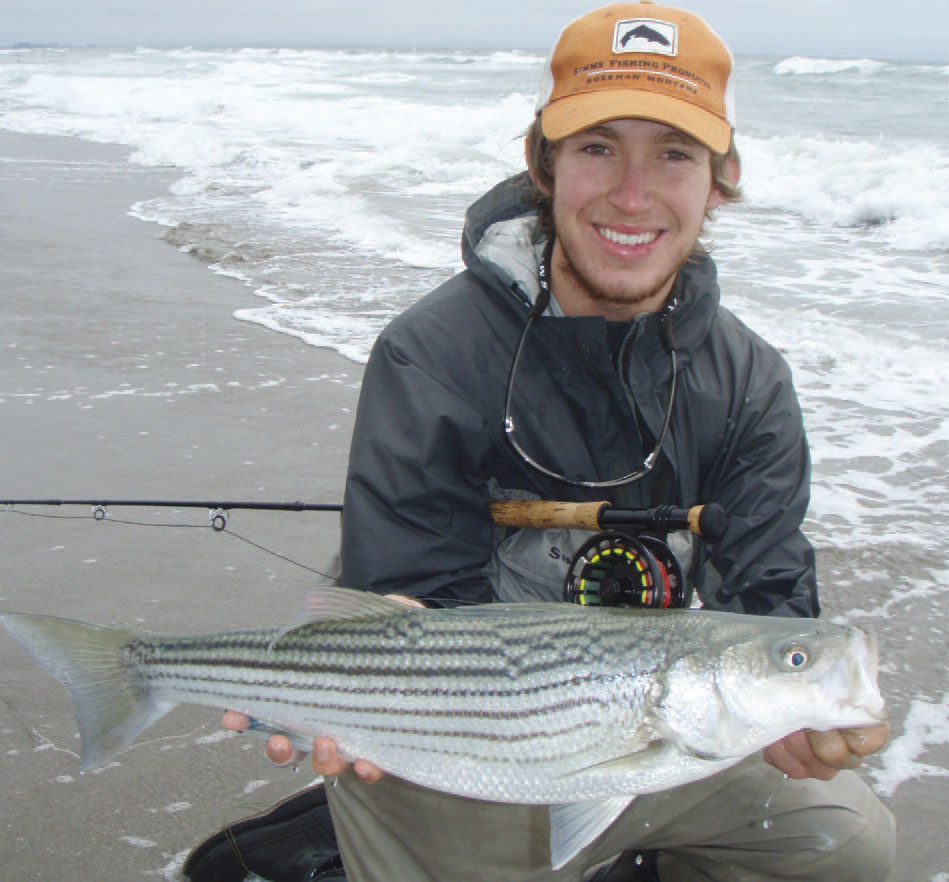
The summer is when the largest numbers of trophy-sized stripers are in the surf, although the spring and fall can produce the occasional fish as well. Stripers can be taken at all stages of the tides, but certain phases tend to be more productive than others. Keying in on the stages of the tide on each side of the low provides allows the angler to get right up on the rips and holes that large stripers frequent. At higher tide levels, the water will push an angler back, well out of casting range. A very low tide can leave these beach contours too shallow to be productive, but as soon as the early incoming tide provides sufficient depth, bass can come surging in to the inshore area to feed. Taking advantage of this window before the incoming tide has had time to make that same structure a 150-foot cast can mean the difference between a great session and a skunk.
West Coast striped bass are a precious resource, and a threatened one, as well. This makes it imperative that when you catch one, you remove them from the water for only the bare minimum amount of time necessary to remove the fly and not risk mortality by dragging it up the beach or hoisting their unsupported weight with a Boga Grip. And of course, carefully release what you catch
Targeting these fish takes persistence and dedication. It will be tempting to switch back to your 6-weight and small Clousers, but stick with it long enough, and the first heart-stopping run of a big striper in this hectic environment will make the nagging thoughts of fast perch action fade. The rewards of this frustrating, at times maddening pursuit make it one of my favorite fisheries anywhere. There are simply few comparably gratifying fly-rod challenges to be had in the Golden State.



